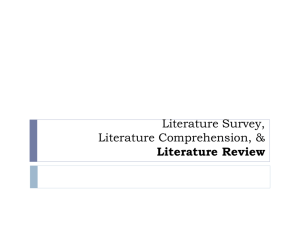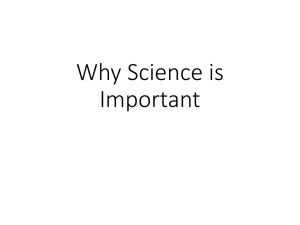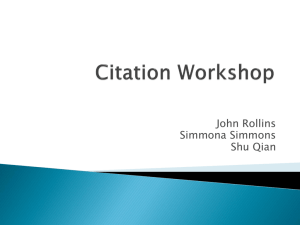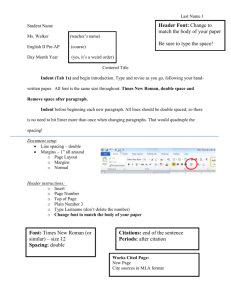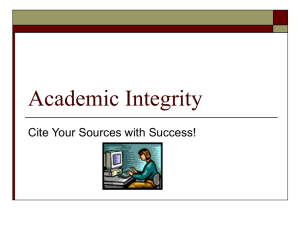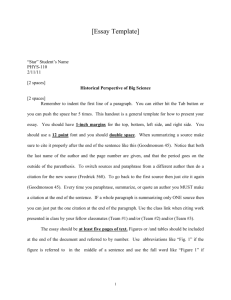Citation and Referencing
advertisement
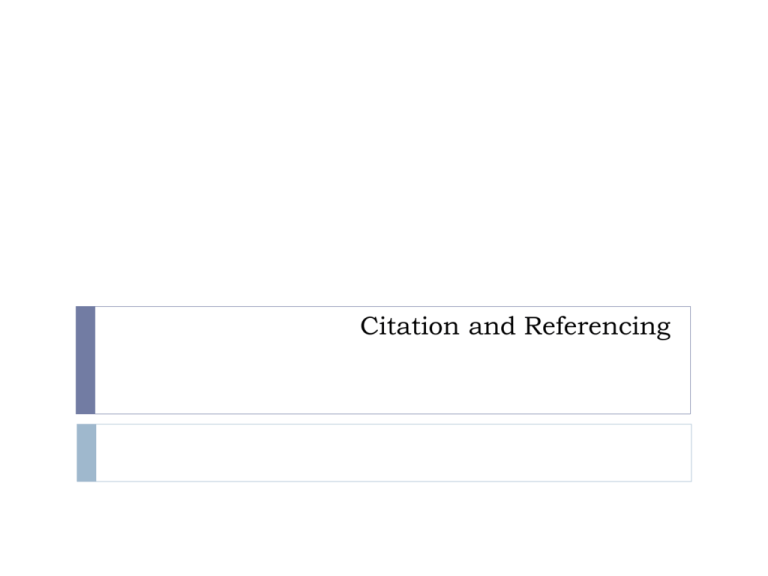
Citation and Referencing Using Sources in your work Provides evidence and examples to support your arguments, propositions, opinions or findings Providing a map to reader of where your work fits And what its based on Allows reader to locate, review and test evidence and examples used Establishes credibility Or to use it for their own purposes Gives recognition to work which you’ve benefited from Demonstrates that you have considered relevant work in the area Using Sources in Your Work To support what you are saying Introduce someone’s work or opinion in order to discuss Show differences between other peoples’ work or opinions Show differences between your own work and that of others Two Things You Need To Know Citing Acknowledging within the text/content of your work the source or sources you are using to build an argument or support an opinion. It is ok to use someone else’s work in this way. Do this when You want to take an section of a source. You want to paraphrase or present a summary of information taken from a source(s). Make it clear why you are using it, put it in quotations and acknowledge the source Be careful! It is not ok simply to rewrite. You must also cite and reference. You want to support your argument or opinion. Here you are simply saying ‘I have read respected sources in the area and these guys agree with me’ Two Things You Need To Know Referencing When you cite someone’s work you must include the full detail of where to find the original text. You do this by including a reference list, usually at the end of your submission. Each reference details The Author(s) Name The Year of Publication The Correct Title Where the source can be located – Details of Publication This enables the reader of your work to locate any sources and read them for themselves. Citing and Referencing Performed as a pair If you cite You must include the full detail in your reference list Handling Common Knowledge Any knowledge that is so well known that it can be found in numerous sources does not have to be cited. E.g. A large number of programming languages use compilers to translate source code to machine executable code. However, some are translated into a form which can be interpreted when needed to form machine code. If however you want to state something about what the efficiency or effectiveness of this you will need to cite a source to support your argument: E.g. A large number of programming use compilers to translate source code to machine executable code. However, some are translated into a form which can be interpreted when needed to form machine code as this is more efficient in a mobile world (Jams 2010). Using Sources in Your Work To report Facts, figures, definitions etc E.g Citation: Standish (2009) showed that only 32% of all software projects were deemed successful. Reference: Standish (2009), Standish Chaos Report 2009. Available: http://www.standishgroup.com/, [Date Accessed: 1st October 2011] Format for Website: Author(s) (Year), Title Of Site In Italics With Each Word Capitalised. Available: URI, [Date Accessed: date] Using Sources in Your Work To acknowledge You are using some particular approach E.g. Citation: The process of developing a literature review used in this lecture is that by Diana Ridley (2008). Reference: Ridley D (2008), The Literature Review: A Step-by-Step Guide for Students, Sage Publications Ltd. Format for Book: Author(s) (Year), Name Of Book In Italics With Each Word Capitalised, Edition If Relevant, Publisher. Using Sources in Your Work Support for your opinion - Quotation: Citation: The Waterfall model is still one of the most recognised models of software development. However, as Boehm (2006) states, “by the end of the 1970’s, problems were cropping up with formality and sequential waterfall processes”. Reference: Boehm, B (2006), ‘A View of 20th and 21st Century Software Engineering’, In The Proceedings Of The 28th International Conference On Software Engineering (ICSE’06), Shanghai International Convention Center, Shanghai, China May 20-28, ACM New York. Format for conference paper: Author(s) (Year), ‘Title of Paper in single quotation marks’, Title Of Conference In Italics With Each Word Capitalised, Edition If Relevant, Location and date of conference, (if known), Place of Publication (if known), page numbers if known. Quoting Use if Use sparingly Literature review is about your thinking Short quotes Author(s) is key researcher or Authoritative You can’t think how you would paraphrase and retain the meaning Run into your text with quotation marks and citation Long quotes Start on separate line Indent Give citation You can leave out words and replace with … Quoting If you quote You need to comment Don’t quote too much Are you really presenting your thoughts and opinions? Summarise and Paraphrase Paraphrase Extract meaning of a short section or paragraph Keep it short Use your own words Make it shorter than the original Include the citation Summarise State in short Make sure you cover key points – leaves out detail Use your own words Include the citation Using Sources in Your Work Support for your opinion – Paraphrase Citation (multiple sources) It is recognised that there are problems in using rigid, formal approaches to software development such as the Waterfall model (Boehm 2006; Green and DiCaterino 1998). Reference: Boehm, B (2006), ‘A View Of 20th And 21st Century Software Engineering’, In The Proceedings Of The 28th International Conference On Software Engineering (ICSE’06), Shanghai International Convention Center, Shanghai, China May 20-28, ACM New York. Green, D. And Dicaterino A. (1998), A Survey Of System Development Process Models, Center For Technology In Government, University At Albany, Available: Http://Www.Ctg.Albany.Edu/Publications/Reports/Survey_of_sysdev/Survey_of_sysde v.Pdf, [Accessed: 24th February 2011] Using Sources in Your Work Support for your opinion – Summary Citation Boehm (2006) presents a review of the discipline of software engineering, tracing its development over the past 60 years. Reference: Boehm, B (2006), ‘A View Of 20th And 21st Century Software Engineering’, In The Proceedings Of The 28th International Conference On Software Engineering (ICSE’06), Shanghai International Convention Center, Shanghai, China May 20-28, ACM New York. Green, D. And Dicaterino A. (1998), A Survey Of System Development Process Models, Center For Technology In Government, University At Albany, Available: Http://Www.Ctg.Albany.Edu/Publications/Reports/Survey_of_sysdev/Survey_of_sysde v.Pdf, [Accessed: 24th February 2011] HARVARD Referencing Name/Date system http://www.dit.ie/study/mature/support/academic/citing/# harvard How to cite The correct way to cite Work by one Author is (Smith, 2005) Work by two Author(s) is (Smith and Jones, 2005) Work by multiple Author(s) is (Smith et al., 2005) Works by the same Author(s) in the same year Sometimes if there are three Author(s) – they can all be listed Distinguish by adding a, b, c etc after the year E.g. (Boehm 2006a; Boehm 2006b) Please note: Since “et al.” is an abbreviation of the phrase “et alia” the full stop is necessary. Additionally as it is a foreign phrase it must always be in italics. How to reference A Book Author(s) (Year), Name of Book in italics, edition if relevant, Publisher. Include the edition if there are multiple editions – you must indicate the one you used Ridley D (2008), The Literature Review: A Step-by-Step Guide for Students, Sage Publications Ltd. A chapter in a book Author(s) (year), ‘Title of chapter in single quotes’, In plus Author(s)/editors of book, Title of Book in Italics, Publisher, page numbers if known. McCann, J M (1994), ‘Generating, Managing and Communicating Insights. In Blattberg’, In R C, Glazer, R and Little, J D C (Eds), The Marketing Information Revolution, Harvard Business School Press, Boston. How to cite/reference A Journal Article Author(s) (year), ‘Title of article in single quotes’, Name of Journal in Italics, Volume, Issue, Page Numbers Bisbal J, Lawless D, Wu B and Grimson J (1999), ‘Legacy Information System Migration: A Brief Review of Problems, Solutions and Research Issues’, IEEE Software ,Vol. 16 (5). A Conference Paper Author(s) (Year), ‘Title of Paper in single quotation marks’, Title of Conference in italics, edition if relevant, Location and date of conference, if known, Place of Publication if known, page numbers if known. Boehm, B (2006), ‘A View of 20th and 21st Century Software Engineering’, In the Proceedings of the 28th international conference on Software engineering (ICSE’06), Shanghai International Convention Center, Shanghai, China May 20-28, ACM New York. How to cite/reference A report by a company where no Author(s) is listed Use the name of the company Standish (2009), Standish Chaos Report 2009. Available: http://www.standishgroup.com/, [Date Accessed: 1st October 2011] A website You must include the URI and the date accessed Green, D. and DiCaterino A. (1998), A Survey of System Development Process Models, Center for Technology in Government, University at Albany, Available: http://www.ctg.albany.edu/publications/reports/survey_of_sysdev/survey_of_sysdev.pdf, [Accessed: 24th February 2011] How to cite/reference What if I read something which cites a source which I haven’t read myself ? And I want to refer to it ? E.g. X’s theory of y (X 1999) as cited in (Z 2000) states that…. Do not use this too often Check this out of the library… Reference Management Software Zotero Endnote ReadCube
